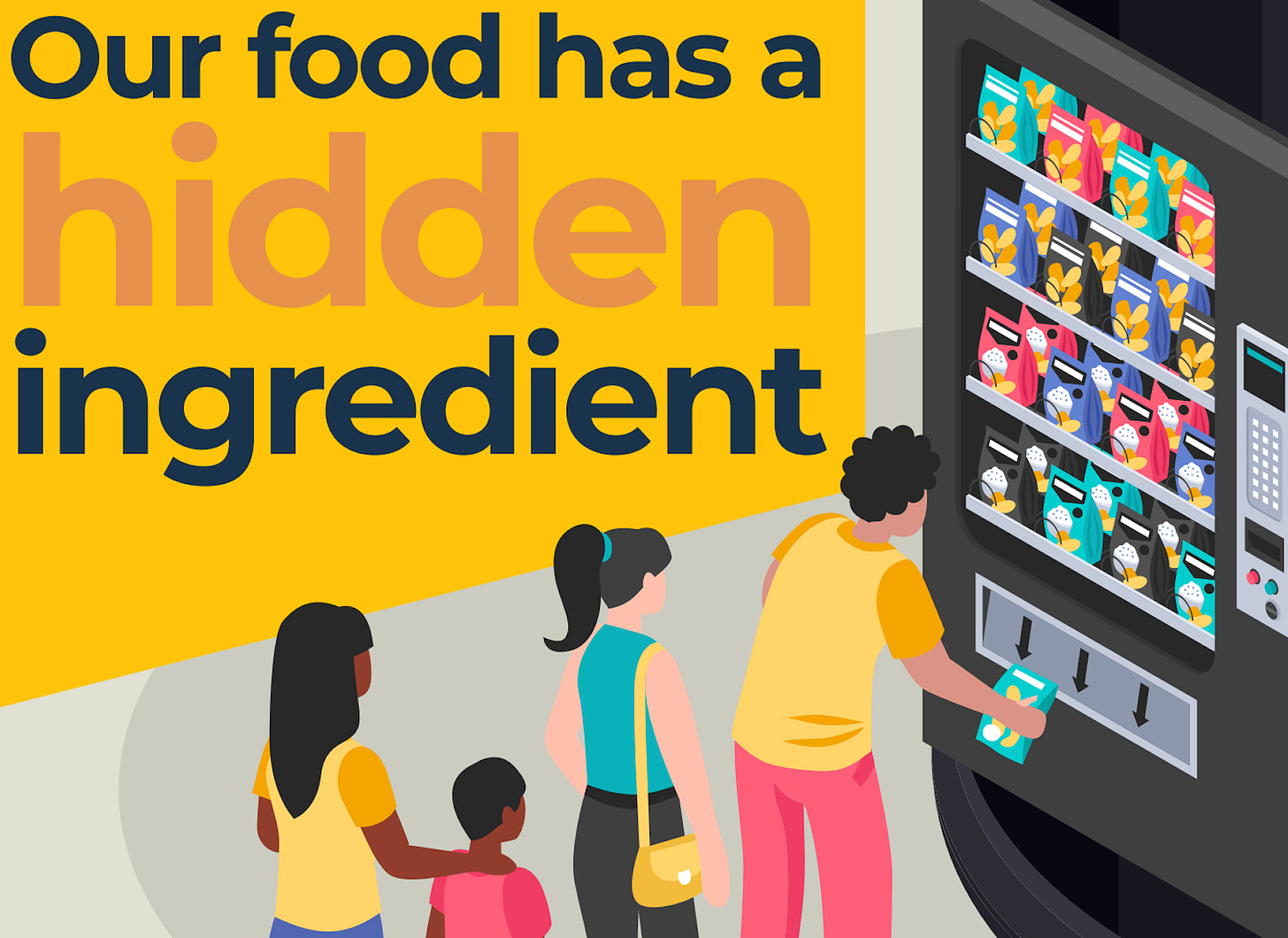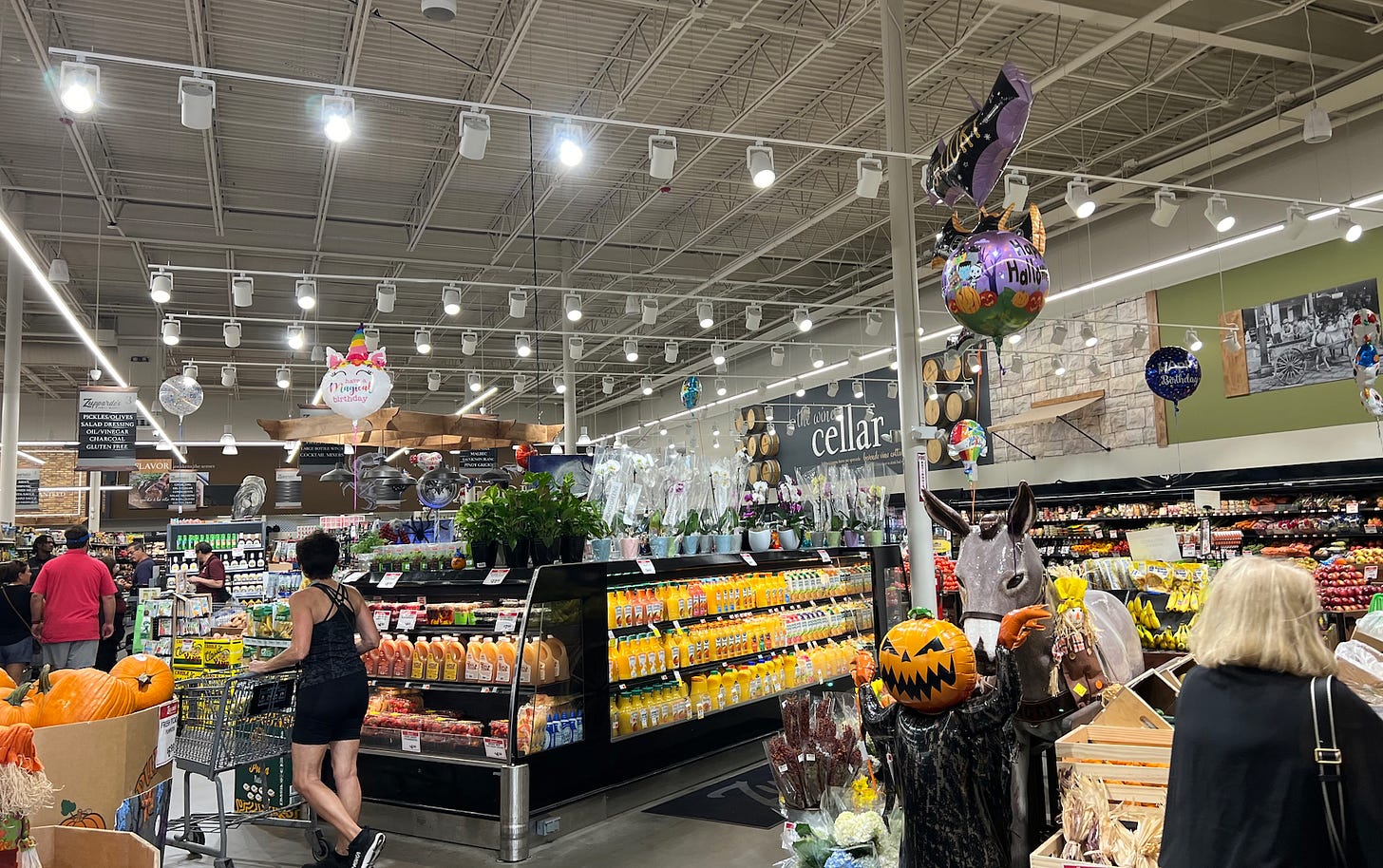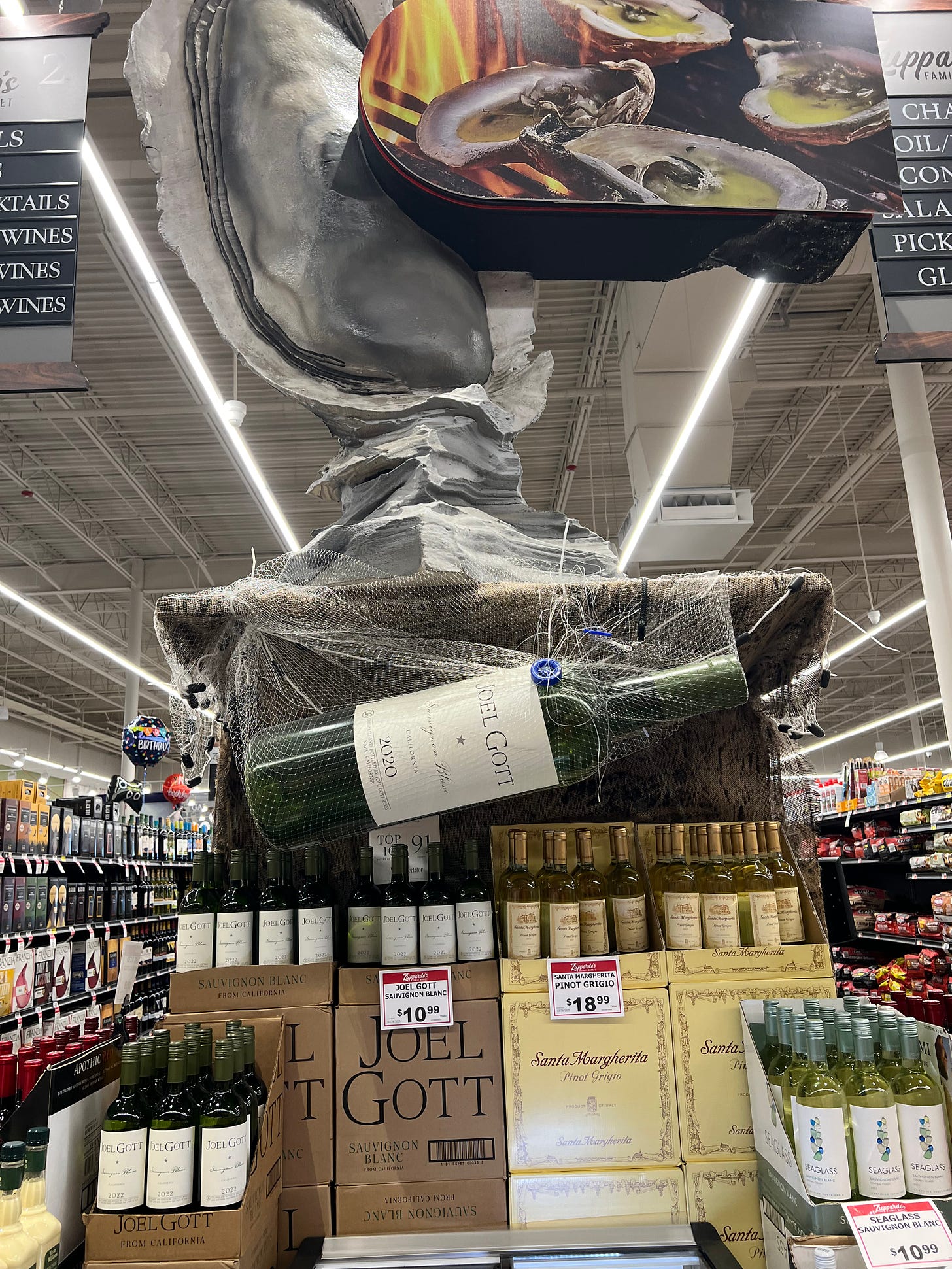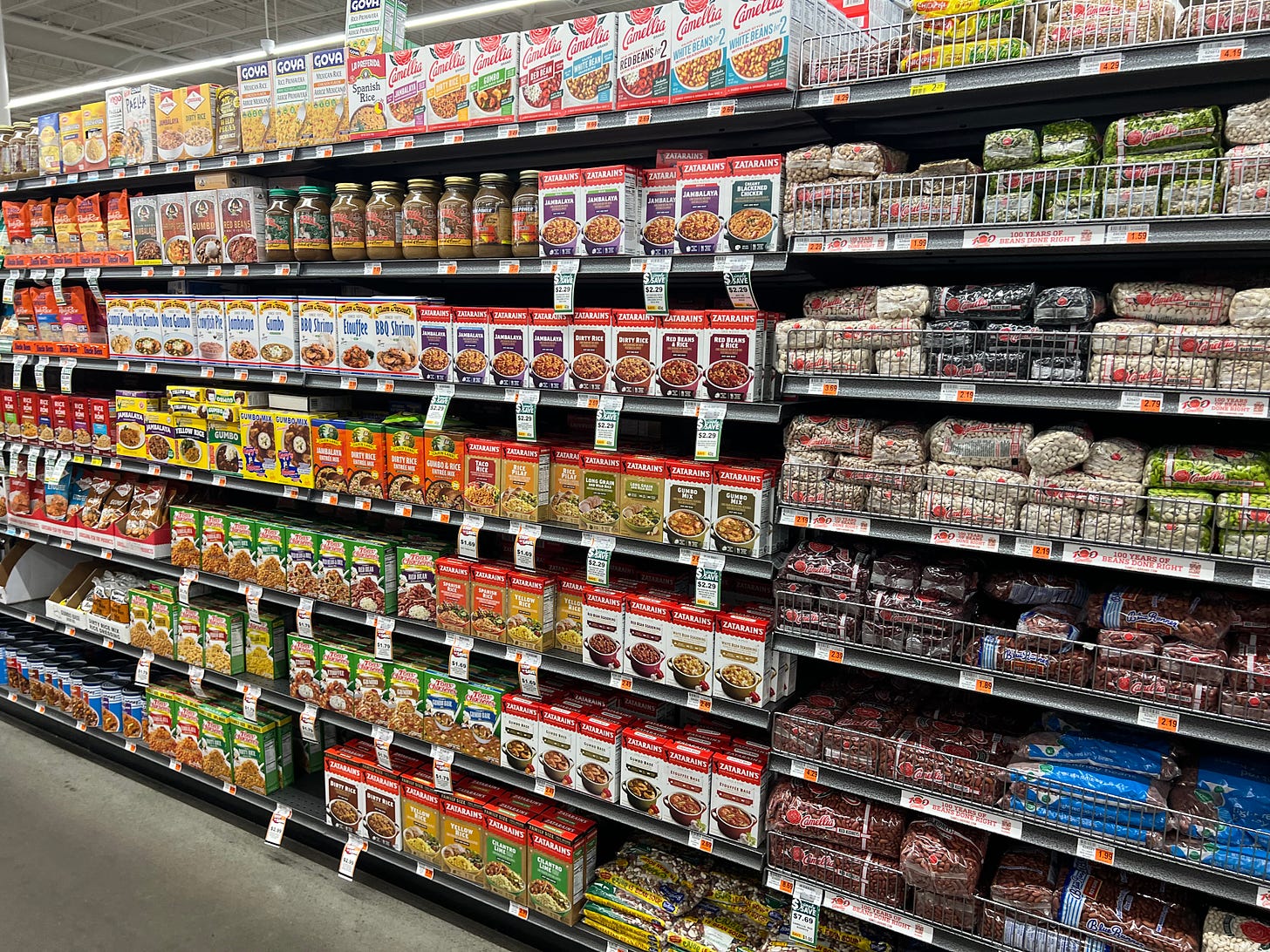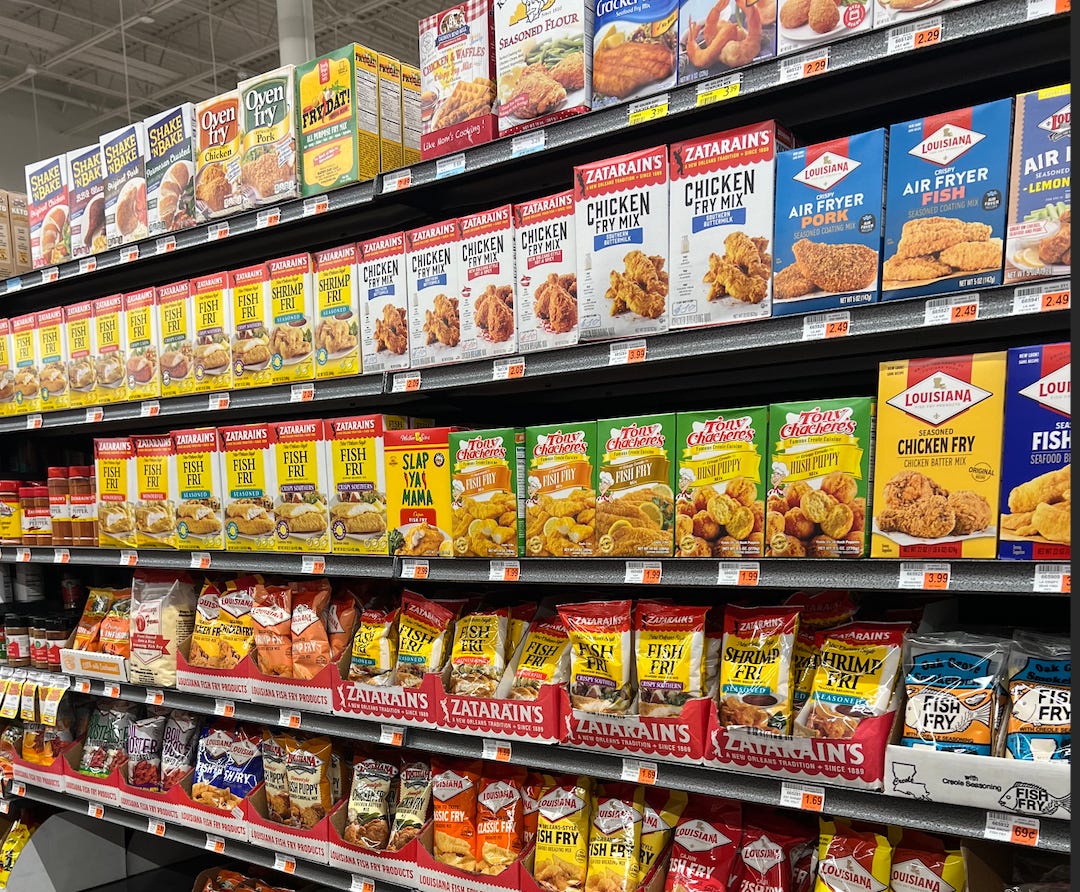Grocery Update #29: A Cajun Grocery Party.
Also: Fossil Fuels and Our Food Supply. & Ozempic Does Not Make You Healthier.
Discontents: 1. Fuel To Fork: Fossil Fuels and Our Food Supply. 2. A Cajun Grocery Party at Zuppardo's. 3. Surprise! Ozempic Does Not Make You Healthier. 4. Tunes.
1. Our Food Supply Is Built on Fossil Fuels.
Think about going to the grocery store, and anything that you're buying. The packaging. Fossil fuel based. The transportation, how it got there. Fossil fuels. The refrigeration, probably fossil fuels. The equipment, the infrastructure... It’s all fossil fuels.
I consider fossil fuels to be, and this isn't a compliment, the lifeblood of the food industry.
I made this claim in Fuel to Fork, a brand new podcast series that delves deep into this hidden ingredient in our food systems.
Launched on Thursday 24 October, Fuel to Fork is a collaboration between IPES-Food, TABLE Debates and Global Alliance for the Future of Food. In 7 episodes, Fuel to Fork exposes how fossil fuels power everything from farm to fork – and what the options are for reducing our dependence on them.
From farm to table, fossil fuels are everywhere in our food systems. They account for 15% of global fossil fuel use through fuel, processing, transport, plastics, refrigeration and cooking.
The majority of fossil fuel consumption is in the processing and packaging stage (42%), and in retail consumption and waste (38%). Farm inputs and powering farms together account for 20% of energy use in food systems.
For every calorie on our plates, around 10 calories of fossil fuels are burnt to get it there. When we talk about the future of food, we often focus on changing what we grow and eat. But, after leaving the farm, the way our food is processed, packaged, and transported plays a huge role in the fossil fuel reliance of our food system. And this stage is becoming even more energy-intensive, thanks to ultra-processed foods and longer supply chains.
Food-related plastics and fertilizers together represent 40% of petrochemical products. As demand for fossil fuels for transport, power, and heating declines due to electrification and demand reduction measures, the fossil fuel industry is investing significantly in petrochemicals to produce plastics and agrochemicals and lock in fossil dependence. Petrochemicals are rapidly becoming the most significant driver of global oil demand (for plastics) and gas demand (for fertilizers), with production expected to increase substantially through 2050. Fertilizers account for 5% of global natural gas consumption. The use of nitrogen fertilizers could still grow by another 50% until 2050.
The global food system is undermining efforts to halt climate change. According to Anna Lappé of the Global Alliance for the Future of Food, “If we don't push conversations like this one, then I think that we could, in trying to solve one problem, we create many more problems… Pesticides are a petrochemical. Nitrogen fertilizers are a form of petrochemicals as well. The International Energy Agency projects that petrochemicals will account for more than two thirds of global oil demand growth by 2026. Plastics and fertilizers together account for about three quarters of all petrochemicals produced, and so they're major drivers of this growth.”
It doesn’t have to be this way.
We choose what we eat and where our food comes from. Humans have shaped 10,000 years of agriculture, and just a fraction of that time has involved fossil fuels. Many of the solutions to this crisis are being explored on the frontlines in the Global South and downstream working class communities in the United States. These solutions are compelling but will require a carefully planned, publicly-financed Just Transition to implement.
According to Anna Lappé, “And so my concern is that if we do not do a better job at bringing those who care about phasing out fossil fuels, together with those about transforming food systems into conversation with each other, that we could miss this huge growth area that industry has set its sights on, which is petrochemicals.”
CIEL Report: https://www.ciel.org/reports/fossil-fertilizers/
Renewable Energy for Agri-Food Systems report: https://www.irena.org/publications/2021/Nov/Renewable-Energy-for-Agri-food-Systems
Power shift report from Global Alliance for Future of Food: https://futureoffood.org/insights/power-shift-why-we-need-to-wean-industrial-food-systems-off-fossil-fuels/
Podcast: https://ipes-food.org/video-and-media/fuel-to-fork-podcast/
2. Cajun Grocery Party At Zuppardo’s.
I understand why people love New Orleans, even tough the weather is horrendous. The food. The people. Southern charm meets Acadian bonhomie. The vibe. It is a unique place and am amazing subculture. Plus, the food. Probably among the top 5 regional American cuisines, up there with Texas BBQ, Tex-Mex, N.Y. Chinese and N.Y./N.J. Italian. IMHO. A stand-in for the American South. Gothic, violent history. So many ghosts, vampires. Halloween’s best party. Music. JazzFest. Blues. Zydeco. A deep Black American cultural history. Louis Armstrong. Mardi Gras. Beads. Katrina, the levees. Lake Ponch. Diverse, cosmopolitan, progressive. Corrupt, racist, reactionary. The terrible weather. Dense, oak-tree lined city neighborhoods. Suburban sprawl and endless stroads. Mold. Humidity. The food. New Orleans is a party, hangover included. Thank gawd for the food.
Zuppardo’s is a case in point.
Family owned with a packed parking lot on the working class end of Metairie. You walk in, the place feels like a party. Air conditioned. Bright, cheerful track lighting on a high, industrial corrugated ceiling. Balloons. Streamers. Potted plants. Yacht rock on the Sirius/XM. Clean, shiny waxed floors, a neutral gray brown. The place smells like flowers and gumbo and good times. I am soooo down.
The produce assortment is not special. Pretty average really, but it looks great. Prices on the high side. Unlined bins of squash and pumpkins (it is late October and still 85 degrees and humid outside). Waxy, industrial apple varieties ending in “crisp” for $1.39. A handsome, well stock fruit cooler, with citrus, grapes, cut watermelons and berries. Bags of lunchbox size grannies. A sizeable organic section, mostly industrial monoculture salads from Watsonville or Coachella Valley, plus cauliflowers, bagged green beans and snap peas. It is fine, adequate. But it looks great.
After produce, alcohol, So much booze. I do not partake but I respect the game. A long cooler of six pack beers from AB-InBev, Molson Coors and the like. Ambient stacks of local beers, malted and hoppy like freshly mowed sawgrass, amidst corporate lite beers. Rows and rows of wine, merchandised by appellation, variety, terroir, all that highfalutin’ wine subculture nonsense to accompany all your good food. Wine is slowly rotting bottled grape juice for fucks sake. But lots of margin in those aisles. Alongside the spirits, the scotch, vodka, whiskey, everything you need to party.
Big piles of freshly caught gulf shrimp and buckets of locally caught crab meat on ice tables, maybe needing more ice. But they must be selling quick enough to not fester. And sausages. A record number of sausage. I thought Pennsylvania, maybe New Jersey was the sausage champ. But New Orleans, with all these jambalayas and gumbos and stews, they are sausage royalty, the reigning icons of salted, spiced, tubular, cured porcine byproducts. Boudin, andouille, smoked with garlic. Toe to toe, packed floor to ceiling next to upright coolers of gulf caught shrimp and a handsome, freshly laid out, full service seafood and meat case. Big piles of meat, lots of family packs, highly industrialized, factory farmed, feedlot finished. All your usual cuts but also big bundles of briskets, roasts, ribs, pork knuckles, chicken gizzards, rabbit from industrial scale rabbit farms. New Orleans Jazzfest? More like Meat Fest.
New Orleans is diverse, the area in Metaire heavily Central American and Hispanic. At least that is my inference from the huge sets of tortillas and assorted Mission, Goya, Malta, La Costena (the O.G. Mexican CPG brand) and assorted Grupo Bimbo noshes.
Center store is an exercise in Cajun/Creole cuisine deconstruction.
Every aisle is a new layer and insight into what makes the Cajun/Creole kitchen hum. And the merchandising is tight. Well laid out, thoughtful, dense, with a big emphasis on local brands as much as mainstream, with Topco private label liberally sprinkled across the categories. Hurricane-ready pantry loaders. Progresso and Campbell’s, a little Amy’s too. Broths and stocks, chicken, beef, bouillons.
Beans. So many beans. More beans than sausages. New Orleans wins the bean wars. Pork ‘n beans, ranch style, baked beans, grillin’ beans, red beans, black beans, chili beans, kidneys, navys, a rainbow of canned legumes. More beans, dry, DIY bagged beans, off all shapes, sizes, colors. Beans also have appellation, variety, terroir, but beans don’t have the respect like wine. Beans FTW. Make Beans Sexy Again. And rice too. Most of an aisle of boxed rice and grains. Your average grocery store usually has a pandering of boxed rice and grain meals. Not the Cajuns. Four full feet of Zatarain’s, plenty of Tony Chachere’s, local options from Kary’s Roux, Cajun Land. Pasta from Topco and local brands. Tomatoes, canned, from Hunts, Muir Glen, Topco, Cento.
A whole aisle of flavor. Guy Fieri would have a sunbleached embolism. Flavor town indeed, packets for your gumbo, your fish fry, crab boil, hush puppies. Cans and shakers and jars, and cello baggies. Slap Ya Mama (no, don’t, please), more Zatarain’s and Tony C’s. A brand just plainly called Louisiana, just hitting you over the head with the obvious, this is Cajun country, you know what to expect. Flavor.
Spices, in Zuppardo’s own brand, McCormick, Badia, rows and rows of spices. Sugar, cooking oil. Industrial, yellow packaging, no imagination here, just reliable old standbys, Crisco, Mazola, Domino, genetically modified, dowsed in herbicides, refined and filtered, ready for your basic kitchen ensemble. Bread, the big names from all the bakery mafias, Sara Lee, Nature’s Own, Sunbeam, Topco, a lone keto bread amongst the highly refined, bleached, shelf stable starch bombs to cradle all that meat. An epic run of coffee, climaxing in a massive set of locally roasted, red-bagged Community. It’s alright. I had it on an airplane once. It’s just coffee.
Fiora paper towels, a power stack, just like in Redner’s. Little Debbie endcaps, giving me a strong nostalgia for my afterschool snacks. Full cookie aisle, blue Oreos, yellow Nillas and Belvitas, red Chips Ahoy, I don’t even need to see labels, just the color schemes. A red run of Coca-Cola, spiked with Sprite, Fresca (subtle NSFW reference to Season 2 of The Boys), Fanta and Dr. Pepper. A snack aisle with some fun local chips and salty crunchy things. But over 75% of the space absolutely dominated by Frito Lay products, at least 32 feet of Doritos, Santitos, Tostitos, Cheetos, Fritos and Bugles. Full spectrum Frito dominance.
And air filters. Everyone sells HVAC filters down here. Makes sense. Right above the bottled water. Commodified air. What’s next, canned air? Just like Spaceballs.
Industrial freezer assortment. Conagra. Tyson. Hungry Man. Lean Cuisine. Ore Ida. McCain. Banquet. More Zatarain’s. Epic frozen pizza aisle, in case you actually get tired of gumbo. Red Baron, DiGiornos, Tombstone, CPK, Totino’s. A smattering of plant based burgers and the like. Atkins entrees, like it was still 2006. Still not making America healthy again.
Deli case, Boar’s Head free. Hopefully Listeria-free. Dietz and Watson bulk sandwich meats. Standard dairy assortment, Topco’s Food Club milks at $4.49-$4.99 gallons hot price, with a local conventional dairy at $6.99, which seems steep for literally the same thing, different label, different farms, different cows. But still commodity milk. Alongside plenty of plant-based alternatives, Silk, Blue Diamond, Planet Oat, Topco’s Full Circle, Malk, Califia. And rows and rows of cakes, confections, cupcakes, pies, dessert before the main course.
The main course, like taking all those scattered packaged and fresh ingredients among the aisles and recombining, transmogrifying them into a warm, savory smelling deli and grab and go section that reminds you beyond a shadow of a doubt what area code, what bioregion, what culinary center you are in. Platters of ziti and lasasgna, beef, cheese and seafood. A hot bar, bulging with collards and ham hocks, red beans and rice, sliced pork sausages, sizable quarters and limbs of golden brown fried chicken. A cold case with yesterday’s hot bar offerings plus seafood gumbo, crawfish ettouffe, lima beans and bacon, stewed shrimp and okra, creole chicken and seafood sausage gumbo. A cooler of sides, egg salad, seafood salad, olive salad, macaroni salad, potato salad, carrot salad, broccoli salad, pimento cheese salad, cabbage salad, um, er, cole slaw, and deviled egg potato salad. A soup cooler, just soup in its many iterations, crab bisque, broccoli cheese soup, shrimp and corn soup, chicken tortilla soups. Liver and onions, for your grandma, because only grandmas eat liver and onions. Rotisserie chickens, in case you don’t jibe with the fried stuff.
Endzone. A row of clean, black, fully staffed cash registers, packed with throngs of customers, carts full. More balloons, streamers, fall season decorations, bright fluorescent lights so you can see your receipts as you thank your cashier. A sign under the exit, “Our House is Your House”, a big cajun hug. “Thank You For Shopping With Us”. They really mean it. The shopping is done. But the party never ends.
3. GLP-1s Do Not Make You Healthier.
“Drugs like Wegovy may trim your waistline but not medical costs. The full-year cost of care for U.S. patients with obesity represents a 46% jump over the average annual medical cost prior to taking the medication. Over the two years, the analysis found "no reduction in obesity-related medical events," such as heart attacks, strokes and diagnoses of Type 2 diabetes, or use of prescription drugs for hypertension and high cholesterol.”
You can’t medicate yourself to a better food system. Who knew.
4. Tunes.
It is kind of impossible to pick one New Orleans music institution. Louis Armstrong. Fats Domino. Dr. John. Lil Wayne. Crowbar. Mahalia Jackson. Allen Toussaint. Wynton Marsalis. The Neville Brothers. The Meters. Yeah. Let’s go with The Meters.
peace.





